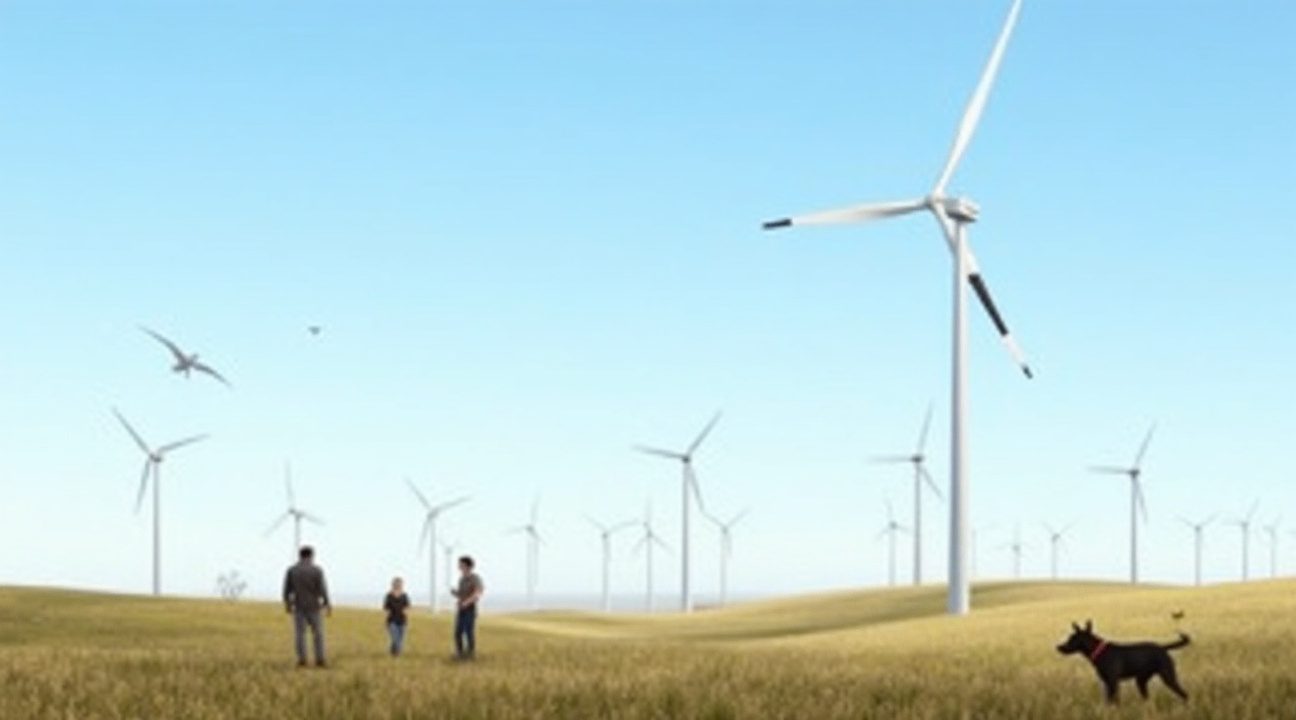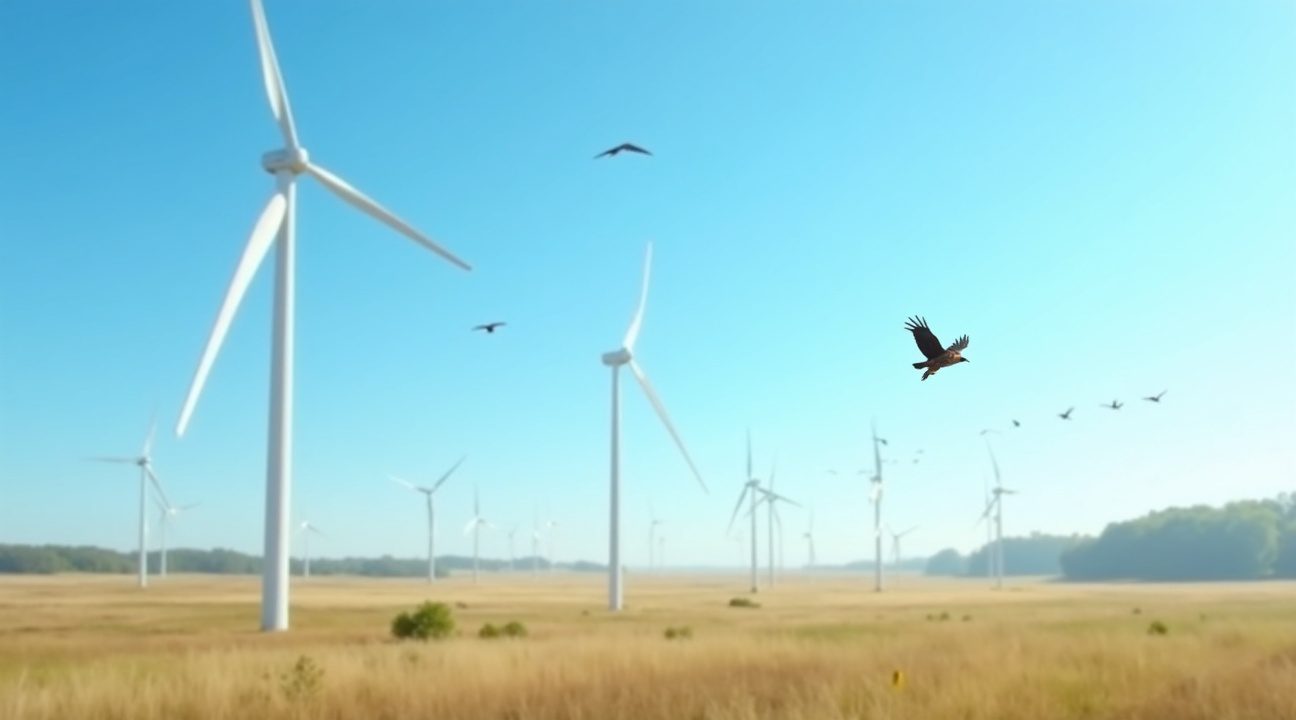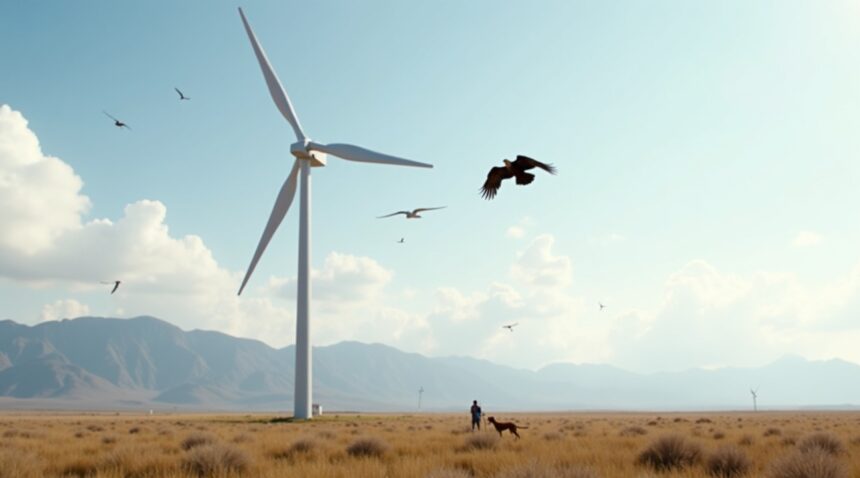A groundbreaking study at Norway’s Smøla wind power plant has shown that painting just one blade of each wind turbine black can reduce bird collision deaths by an impressive 72 percent.
Key Takeaways
- Painting one turbine blade black reduces bird fatalities by approximately 70–72% by increasing blade visibility and disrupting the motion smear effect.
- The method is both simple and cost-effective, requiring no complex systems like radar monitoring or acoustic deterrents. It also eliminates the need for electricity and high maintenance costs.
- Validation studies are underway by researchers at Oregon State University across various sites in North America to assess the solution’s effectiveness on different bird species and in different environmental settings.
- Implementation challenges do exist, particularly due to regulatory barriers such as Federal Aviation Administration (FAA) color modification rules and concerns about potential thermal loading in hotter climates.
- Long-term research is essential to evaluate the lasting impact across migration patterns and seasonal bird activity, ensuring that the solution is viable year-round.
For more information on efforts to make wind energy safer for wildlife, visit the Oregon State University news release about the study.
Simple Black Paint Reduces Wind Turbine Bird Deaths by 72 Percent
A groundbreaking study conducted at Norway’s Smøla wind power plant has discovered that painting just one blade of each wind turbine black dramatically reduces bird fatalities. The research revealed an impressive 72 percent decrease in annual bird collision deaths, offering a remarkably simple solution to a significant environmental challenge facing the renewable energy industry.
The Norwegian research team monitored bird deaths before and after implementing the black blade treatment across multiple turbines at the facility. This straightforward intervention works by increasing the visual contrast of the rotating blades, making them more visible to birds in flight. Scientists believe the enhanced visibility helps birds detect and avoid the spinning turbines more effectively than when all blades remain their standard white color.
North American Validation Studies Underway
Researchers at Oregon State University have recognized the potential impact of this discovery and are now expanding the research across North America. Their goal involves validating the effectiveness of black blade painting for different bird species found throughout the continent. Each region presents unique avian populations with varying flight patterns, visual capabilities, and migration routes that could influence the success of this intervention.
At a wind farm in Wyoming, scientists have painted between 28 and 30 turbine blades black as part of this comprehensive study. The research team deploys specialized dog teams to systematically assess bird and bat fatalities around both treated and untreated turbines. These canine units are trained to locate deceased wildlife that might otherwise go undetected in the vast landscapes surrounding wind installations.
The Wyoming study represents a crucial step in determining whether the Norwegian findings translate to North American conditions. Different bird species exhibit varying levels of visual acuity and flight behavior, factors that could significantly impact the effectiveness of the black blade approach. Researchers carefully track collision rates, species identification, and environmental conditions to build a comprehensive dataset.
Initial observations from the Wyoming site show promising results, though researchers emphasize the need for extended monitoring periods to account for seasonal variations and migration patterns. The team expects to collect data over multiple years to ensure statistical significance and account for natural fluctuations in bird populations and behavior.
This research addresses growing concerns about wind energy’s impact on wildlife populations. While wind power provides essential clean energy benefits, bird collisions have raised questions about balancing renewable energy development with wildlife conservation. The black blade solution offers hope for maintaining both environmental goals simultaneously.
The simplicity of the intervention makes it particularly attractive for widespread implementation. Wind farm operators can easily apply black paint to existing turbines without requiring complex modifications or expensive equipment upgrades. This cost-effectiveness could accelerate adoption across the industry if North American studies confirm the Norwegian results.
Scientists continue monitoring various factors that might influence the black blade effectiveness, including:
- Weather conditions
- Time of day
- Seasonal bird activity patterns
The research also examines whether the treatment affects different bird species equally or if certain types benefit more than others from the enhanced visibility.
The ongoing studies represent a collaborative effort between renewable energy companies, wildlife agencies, and academic institutions. This partnership ensures that research findings will translate into practical applications that benefit both the wind energy industry and bird conservation efforts. Success in North America could lead to regulatory recommendations or industry standards incorporating black blade treatments as standard practice for new wind installations.
Early results suggest that this simple paint application could revolutionize how the wind energy industry approaches wildlife protection, demonstrating that effective conservation solutions don’t always require complex technology or massive investments.

How Motion Smear Makes Turbine Blades Invisible Death Traps for Birds
Fast-spinning wind turbine blades create a dangerous optical illusion that turns these renewable energy structures into deadly obstacles for birds. Motion smear, a visual phenomenon that occurs when objects move at high speeds, causes turbine blades to appear as an invisible blur to avian eyes. Birds simply can’t detect the rapidly rotating blades until it’s too late to change course.
Understanding the Motion Smear Effect
Hagen from Oregon State University uses a bicycle wheel analogy to explain this deadly visual trick. When bicycle spokes spin quickly, they become nearly impossible to see clearly—the same effect happens with wind turbine blades from a bird’s perspective. The three white blades blend together during rotation, creating an almost transparent barrier that birds fail to recognize as a solid obstacle.
This invisibility problem particularly affects raptors and other large birds that rely heavily on visual cues for navigation. These species have evolved to spot stationary or slowly moving objects but struggle with the high-speed rotation of modern wind turbines. The result is often fatal collisions that could be prevented with better blade visibility.
How Black Paint Creates Life-Saving Contrast
Painting just one blade black dramatically improves visibility by breaking up the motion smear effect. The contrasting black blade creates a visual disruption pattern that helps birds recognize the spinning turbine as a solid obstacle rather than empty space. This simple modification gives birds the visual cues they need to detect and avoid the blades.
Recent studies demonstrate remarkable results from this straightforward solution. Research shows that adding black paint to a single blade reduces bird fatalities by approximately 70 percent. The contrast doesn’t need to be perfect or cover the entire blade—even partial black coloring provides enough visual disruption to alert approaching birds.
I find this solution particularly compelling because it addresses the core problem without requiring complex technological modifications. Wind farm operators don’t need to install expensive detection systems or alter turbine mechanics. A coat of black paint on one blade per turbine can save thousands of bird lives annually while maintaining the turbines’ energy production efficiency.
The effectiveness varies slightly among different bird species, but the overall impact remains consistently positive across various studies. Raptors, which face some of the highest collision rates, show particularly strong responses to the improved blade visibility. This research offers hope for reducing renewable energy’s unintended impact on wildlife populations while continuing the crucial transition away from fossil fuels.
Watch a related video below to see how motion smear affects bird vision and turbine safety:
https://www.youtube.com/watch?v=sp4kU-9A1G8

Black Paint Outperforms Complex Bird Protection Systems
Traditional bird protection systems at wind farms rely on sophisticated detection technologies that can prove both expensive and challenging to maintain. Acoustic deterrents blast specific frequencies to scare birds away, while radar monitoring tracks approaching flocks and triggers automated shutdowns when necessary. Bio-acoustic systems broadcast predator calls or distress signals, requiring constant calibration and species-specific programming.
These high-tech solutions demand significant operator involvement and ongoing maintenance costs. Radar systems need skilled technicians for calibration, and automated shutdowns can reduce energy production substantially when bird activity peaks during migration seasons. Many facilities struggle with false alarms that unnecessarily halt turbine operations, creating additional financial strain.
Simple Paint vs. Complex Technology
Painting one blade black presents a stark contrast to these elaborate systems. This approach requires no electricity, produces no ongoing operational costs, and needs minimal maintenance beyond occasional touch-ups. I find this particularly compelling given that complex bird protection systems often fail during critical moments due to equipment malfunctions or power outages.
The visual contrast created by a single black blade helps birds perceive the rotating turbine as a solid object rather than invisible motion blur. Unlike deadly bird encounters that occur when detection systems fail, this passive solution works continuously without human intervention.
However, researchers acknowledge that more comprehensive studies are essential. Current data focuses primarily on specific locations and bird populations, leaving questions about effectiveness across different species and environments. Long-term durability testing of specialized paints under various weather conditions remains incomplete.
Federal protection laws add another layer of complexity to bird conservation efforts at wind farms. The Migratory Bird Treaty Act and the Bald and Golden Eagle Protection Act impose strict penalties for harming protected species, making effective bird deterrence systems legally crucial for wind farm operators. These regulations drive demand for proven solutions that demonstrate measurable results.
Paint-based protection offers particular advantages in remote locations where maintaining complex electronic systems proves challenging. Mountain ridges and offshore installations often lack reliable internet connectivity for remote monitoring systems, making low-tech alternatives especially valuable.
While blade painting shows remarkable promise with its 70% reduction in bird deaths, the wind industry needs broader validation across diverse ecosystems and species populations. Current evidence suggests this simple intervention could revolutionize bird protection efforts, but additional research will determine whether these impressive results hold true across different geographical regions and seasonal patterns.
Research Limitations Require Larger Studies Before Widespread Adoption
I recognize that the Norwegian study represents an encouraging first step, but the research encompassed only a small number of turbines over a limited timeframe. This initial investigation provides valuable preliminary data, yet scientists need much broader studies before recommending blade painting as standard practice across wind farms.
Scale and Scope Challenges
The Norway wind study examined just four turbines painted with single black blades compared to four control turbines. While the 70% reduction in bird deaths appears significant, I understand that such a small sample size can’t account for variables like seasonal migration patterns, local bird populations, or regional environmental factors. PacifiCorp Wyoming research and similar studies must expand to include hundreds of turbines across multiple geographic regions before drawing definitive conclusions.
Species-Specific Effectiveness Questions
Different bird species exhibit varying flight behaviors and visual capabilities, which means the black blade technique might work better for some species than others. I find it particularly important to study how this approach affects raptors and other threatened bird populations that are most vulnerable to turbine strikes. Current research hasn’t adequately examined whether the method proves equally effective for eagles, hawks, owls, and smaller songbirds that migrate at different altitudes and times of day.
Climate considerations also demand attention since wind patterns, visibility conditions, and seasonal weather variations differ dramatically between Norway’s coastal environment and other wind farm locations worldwide. I believe researchers must investigate how factors like fog, snow, rain, and extreme temperatures might affect the visibility and durability of black paint applications.
The maintenance implications remain unclear as well. Wind turbine blades endure constant stress from rotation, weather exposure, and debris impact. I question whether black paint will maintain its visibility properties over time or require frequent reapplication, potentially increasing operational costs and downtime. Additionally, the paint’s weight distribution on single blades could theoretically affect turbine balance and performance, though no studies have examined these engineering concerns.
Conservation groups express cautious optimism about the technique’s potential for protecting endangered species, particularly large raptors that suffer disproportionately from turbine strikes. However, I emphasize that premature adoption without comprehensive testing could lead to false confidence in an incomplete solution. The energy industry needs solid scientific evidence before investing in widespread blade painting programs that might prove ineffective or problematic in different environments.
Large-scale trials should examine:
- Cost-effectiveness
- Environmental impact of paint materials
- Long-term durability
- Effectiveness across diverse ecosystems and bird migration routes
Only through such comprehensive research can the wind industry confidently implement this promising but still unproven bird protection strategy.
https://www.youtube.com/watch?v=1ZhKxnDY3pE
Regulatory Barriers and Climate Concerns Present Implementation Challenges
The promising bird mortality reduction results from black blade painting face significant hurdles that slow widespread adoption. I’ve observed that regulatory frameworks haven’t kept pace with this innovative conservation approach, creating unexpected roadblocks for wind farm operators.
Federal Aviation Administration Restrictions Limit Color Modifications
The U.S. Federal Aviation Administration currently maintains strict regulations regarding turbine blade color alterations, presenting a major implementation barrier. These FAA regulations require wind turbines to maintain specific visibility standards for aircraft safety, typically mandating white or light-colored blades that contrast against various sky conditions. Wind farm developers must navigate lengthy approval processes to modify blade colors, even for proven bird protection measures.
Climate considerations add another layer of complexity to black blade implementation. Thermal loading becomes a critical concern in warmer regions where black surfaces absorb significantly more solar radiation than traditional white blades. I understand that this increased heat absorption could potentially affect turbine performance through several mechanisms:
- Elevated blade temperatures may alter aerodynamic properties
- Thermal expansion could impact blade structural integrity
- Higher operating temperatures might reduce overall turbine efficiency
- Cooling systems may require modifications to handle increased thermal loads
Technical evaluation remains essential before broader deployment, particularly in desert regions and tropical climates where thermal effects would be most pronounced. Engineers must assess whether the bird mortality benefits outweigh potential performance reductions in these challenging environments.
Some manufacturers have begun exploring alternative approaches, such as painting only blade tips black or using heat-reflective black coatings. These solutions attempt to maintain bird visibility benefits while minimizing thermal concerns. However, research hasn’t yet determined whether partial black coverage provides the same 70% mortality reduction observed in full-blade treatments.
Regional climate data becomes crucial for implementation decisions. Areas with moderate temperatures and frequent cloud cover present fewer thermal challenges than sun-intensive locations. I’ve noticed that northern European wind farms, where the original study occurred, experience different thermal conditions than installations in Arizona or Texas.
The regulatory approval process also varies by jurisdiction, with some countries showing more flexibility than others regarding turbine modifications. Environmental agencies must balance aviation safety requirements against wildlife protection goals, often requiring extensive documentation and testing before approving color changes.
Cost considerations compound these challenges, as specialized black coatings and application processes increase project expenses. Wind farm operators must weigh the financial investment against potential environmental benefits and regulatory compliance costs. Despite these obstacles, the substantial bird mortality reduction demonstrates clear conservation value that wildlife protection advocates continue to champion.
Future Research Will Determine if Black Blades Become Industry Standard
Oregon State University researchers aren’t stopping with their initial promising findings. They’re expanding their studies to examine how blade painting affects different bird species across various geographic regions and environmental conditions. This broader research approach will help determine whether the 70% reduction in bird deaths holds true across diverse ecosystems and migration patterns.
Long-term Data Collection Drives Policy Decisions
The scientific community recognizes that short-term studies, while encouraging, can’t fully capture the complex interactions between wind turbines and bird populations. Researchers need several years of data to account for seasonal variations, changing migration routes, and potential behavioral adaptations by birds. Long-term studies will also reveal whether painted blades maintain their effectiveness over time and whether any unintended consequences emerge that weren’t apparent in initial trials.
Key factors researchers are monitoring include:
- Effectiveness across different bird species, from small songbirds to large raptors
- Performance variations in different weather conditions and lighting scenarios
- Potential impacts on turbine efficiency and maintenance requirements
- Cost-benefit analysis for widespread implementation
- Durability of paint treatments under harsh environmental conditions
Policy adoption typically follows extensive scientific validation, and the wind energy industry operates under strict environmental regulations. If ongoing research continues to demonstrate significant bird mortality reductions without compromising turbine performance, regulatory agencies will likely consider mandating black blade painting as a standard bird protection measure. This could represent a major shift in how the industry approaches wildlife conservation while maintaining renewable energy production goals.
The implications extend beyond individual wind farms. Should black blade painting become an industry standard, it would influence turbine design specifications, manufacturing processes, and maintenance protocols across the entire sector. Energy companies are already monitoring the research closely, recognizing that early adoption of proven bird protection measures could provide competitive advantages and demonstrate environmental stewardship.
Current studies are also examining whether other blade modifications, such as different paint patterns or alternative color schemes, might offer even greater protection. Some researchers are investigating UV-reflective coatings that could make blades more visible to birds while remaining less noticeable to humans. These investigations could lead to more sophisticated solutions that address the unique visual capabilities of different bird species.
The transition from research to widespread implementation will depend on conclusive evidence that black blade painting consistently reduces bird deaths across multiple studies and environments. Once this threshold is met, the wind energy industry could see its first major standardized wildlife protection measure, setting a precedent for future innovations in renewable energy technology.
Sources:
Oregon State University – Scientists studying impact of painting wind turbine blade black to reduce bird collisions
Robin Radar – How to prevent bird deaths at wind farms
American Wind Wildlife Institute – Paint it Black Research Brief
OPB (Oregon Public Broadcasting) – Oregon researchers hope to reduce bird turbine collisions with black paint
Bats and Wind Energy Cooperative – Minimization and Deterrence
WindExchange (U.S. Department of Energy) – Wind Turbines and Birds


